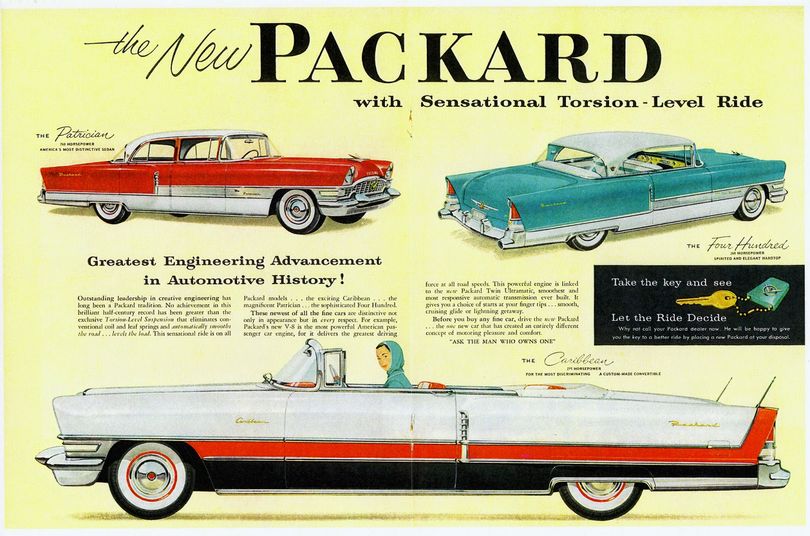Collector Car Corner: The demise of the Studebaker-Packard Corporation

Q: Greg, I am not what you would call a car buff but I think we are fortunate to have someone who is living in our midst. Each week I read your very informative column here in New York. Back in the late 40s and 50s my grandfather bought a series of Studebaker cars: the first being a Land Cruiser (fine car: a 1950, I think) followed by others of increasingly poor quality, but increasingly more radical in design.
When I was in college and needed a car in 1956, he financed for me what I thought was the most wonderful car on earth, a used 1953 Studebaker Champion coupe. This car, I believe the precursor to the Hawk, was a racy two-door, with a flat-six engine and a three speed manual with the lever on the steering column. It also had a ³Hill-hold,² activated by depressing the clutch pedal and taking your foot off the brake, plus a toggle switch on the dash that turned on a fourth cruise gear for increased economy. The windows leaked, the engine tended to blow head gaskets, and I wore out a clutch; still it was racy in a two-tone paint job, and was a worthy substitute for those rich kids driving Jaguars and 190 Mercedes at least in looks, sort-of.
I have read some about the demise of Studebaker, and you have commented on it in your column; still, I am curious about what really happened. It seemed to me to be a matter of poor management, or corrupt corporate action (especially with the purchase of Packard). Also, it seemed to me that just about the only thing that could save the company was the Hawk series, one of the first and most appealing cars of the modern era, or so I thought. But, they abandoned that for the Lark and a limited edition Avanti, which to me was way too far out at the time to sell.
I looked at a Lark when it came time to turn in my college wheels, but it looked and acted like a tin tub on wheels, and, of course, didn¹t buy. I bought a Volvo 544 instead. Can you comment on the management and activities of Studebaker in its dark days? I wonder if one of the oldest car (and wagon) companies in the US might have been saved. Thanks a lot, Thomas F. Nytch, Owego, NY.
A: Thomas, I appreciate your letter very much, especially because you are not a car buff yet did find time to write this letter.
You are certainly ³point on² in your assessment the many errors of Studebaker and Packard, especially Studebaker. Specifically, when Packard agreed to merge with Studebaker in 1954, Studebaker had way more dealers than Packard, but its cash flow position was way worse than Studebaker presented at the negotiation table. (Yes, that¹s corporate corruption.)
So, to sum up the merger, Packard signed into a merger trust that it did not realize included massive mismanagement by Studebaker. Packard¹s hope that it could sell more vehicles ala the strength of Studebaker dealerships never materialized, and it was all troublesome from the word go.
What many aren¹t aware of is why the Studebaker-Packard merger was originally proposed. It all reverts back again to a name I write about quite a bit in this column, namely George Mason. Mason was the man behind the success of Nash-Kelvinator and then pulled off the successful merger with Hudson to form the new American Motors Corporation, also in 1954.
The special ³behind closed doors² covenant found Mason and then Packard president James Nance working a deal where a powerful four-brand American Motors Corporation would be formed, with AMC absorbing the new Studebaker-Packard Company and touting a strong four brand company to include Nash-Hudson-Studebaker and Packard.
Sad thing was, George Mason died suddenly in 1954, and the agreement never materialized as Packard¹s strong balance sheet was off-set by the Studebaker mismanagement. Had both of these companies merged, they would have had the third largest car company in America, replacing Chrysler as a ³big three² American car maker and moving it down to fourth. However, with everything falling apart and Mason deceased, Nance resigned in 1956 and the Studebaker Company, with the Packard name removed for good in 1959, lasted only until 1962 in America and 1966 in Canada.
The big loser was the loss of the luxurious and highly regarded Packard car line, which to this day commands top dollar as a collector car. I also agree that the Studebaker Hawk was way ahead of its time, and to this day still looks good at the car shows. As for the Lark, it was merely a ³re-skinned² 1958 Studebaker, as you found out in your test drive!
Thanks again for your great letter.
